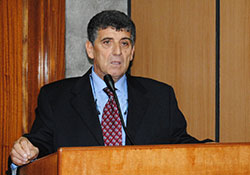A first-hand account of life on the front line of migrant arrivals in Italy

Over the course of 25 years working on the front line of migrant and refugee inflows on the Italian island of Lampedusa, Dr Pietro Bartolo has seen many tragedies among the approximately 300 000 arrivals, but he has also had positive experiences. Sometimes he has experienced both at the same time. Here, he describes one such instance.
One of the most beautiful experiences of my career took place on one of the most tragic days in recent history. On 3 October 2013 the harbour staff called me to say they were facing a catastrophe and asked me to come and help. I replied that I was already there, since we were waiting for two ships that had set off the night before, carrying several hundred Syrians.
The ships with the Syrians never arrived. Instead, the boats of Lampedusans began arriving, with Syrians that they had rescued from the water. The first boat arrived with 47 boys, all greasy from petrol. Fifteen minutes later another boat arrived. When I boarded it, as I usually do, I found 17 boys and four dead bodies already placed in body bags. Upon closer inspection I saw that one of them was still alive and I asked the captain of the ship to help me. We took her out of the body bag and hurried to the hospital. We spent 30 minutes resuscitating her; her lungs were full of water and gasoline. After half an hour, her heart started beating again. Kebrat is now healthy and living in Sweden.
This episode was so gratifying. I examined 368 dead bodies that day, but I also rescued one person.
In Italy, we now recognize 3 October as a day of remembrance. Exactly three years after the tragedy of 2013, many of the survivors from that day returned to Lampedusa to visit the families who had hosted them. I returned from Milan to Lampedusa very late and thought the celebration had already finished. When I arrived at the airport, I saw a dozen journalists with cameras and assumed they were waiting for someone else. In fact, they were there for me. At that point a beautiful pregnant girl approached me and she told me that she was Kebrat. I could not even believe it, since I had seen her on the brink of death three years before. We cried with happiness and spent all the next day together. We still keep in touch.
All health workers who work on the front lines of migration have to approach migrants from a human point of view. They must remember that the people arriving in their country are not numbers; they are individuals with a name, a family, a story – always a sad one, including great suffering. Once they arrive, we must receive them with humanity.



